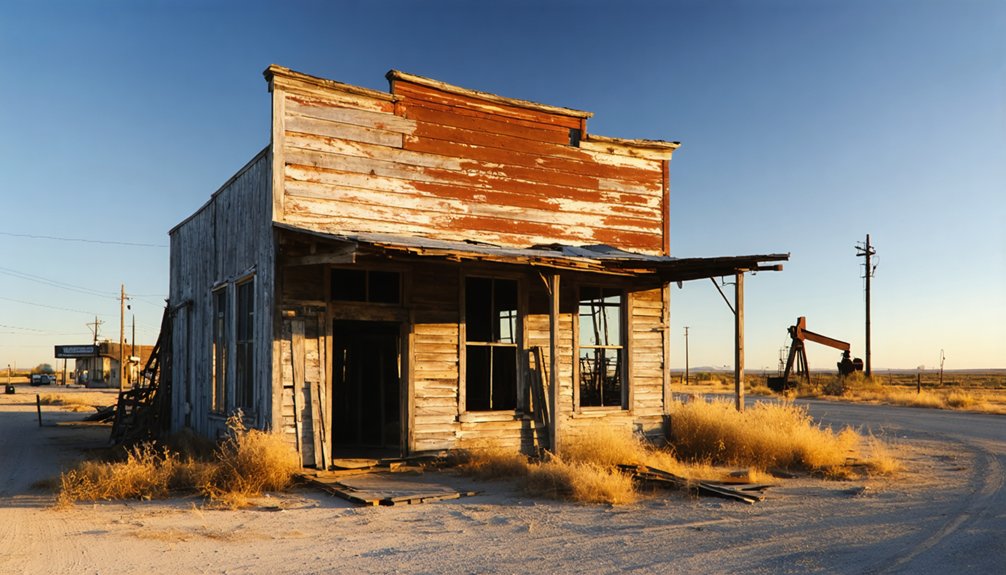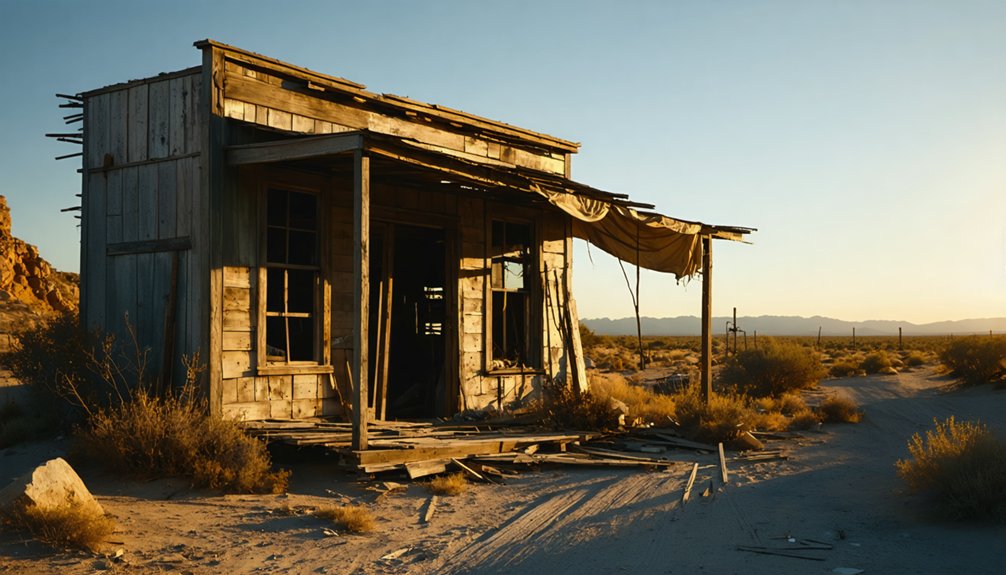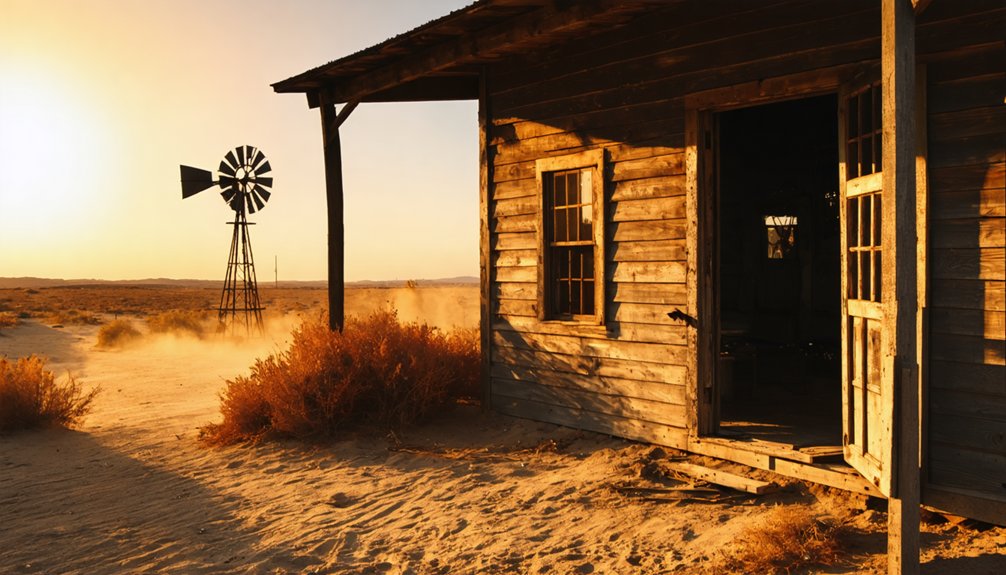You’ll find Bitter Creek in northeastern Nolan County, Texas, where pioneering families like the Bardwells and Montgomerys first settled in the 1880s. The town got its name from a nearby stream’s unpalatable, mineral-rich water. After Michael L. Benedum’s 1923 oil discovery, it briefly boomed as roughnecks and wildcatters poured in. Today, no structures remain at the site, though its story reveals fascinating patterns of 19th-century Texas settlement and resource management.
Key Takeaways
- Bitter Creek was established in the 1880s as a ranching community in northeastern Nolan County, Texas, named after nearby mineral-rich water.
- The town experienced rapid growth during the 1923 oil boom following Michael L. Benedum’s discovery at Big Lake.
- Economic challenges, dependency on ranching and oil, and transportation changes led to the town’s eventual abandonment.
- No physical structures or ruins remain at the site today, with the land returning to its natural state.
- Local museums and historical societies preserve Bitter Creek’s memory through exhibits, festivals, and educational programs.
Early Settlement and Founding Families
As pioneers ventured into northeastern Nolan County, Texas in the early 1880s, the Bardwell and Montgomery families established what would become the settlement of Bitter Creek.
These founding families tackled the settlement challenges of transforming raw land into a livable community south of present-day Sweetwater. You’ll find their legacy in the early development of the area, where they cleared land for farming and ranching while building the first homes and community structures. The area required careful documentation to avoid confusion with other locations named Bitter Creek sites. The town became an incorporated area with its own local government.
Living in isolation, these families formed a tight-knit rural society that relied on self-sufficiency and mutual support. They managed local resources, particularly water, and maintained connections with nearby towns for essential supplies.
Their determination to create a sustainable community laid the groundwork for what would eventually become a notable, though short-lived, Texas settlement.
The Origin of Bitter Creek’s Name
While the exact location remains unknown today, Bitter Creek earned its name from a nearby watercourse that likely contained unpalatable water due to high mineral content.
You’ll find this naming convention was common throughout Texas, where settlers frequently named places based on their experiences with water quality and natural features.
Like its counterpart in Hall County, Texas, which got its name from saline springs, Bitter Creek’s name reflected the presence of alkali or mineral deposits that made the water taste bitter.
This naming pattern wasn’t unique to Texas – you’ll discover similar Bitter Creeks across the United States, from Wyoming to Utah, where comparable water conditions existed.
The name served a practical purpose, warning settlers about the challenging environmental conditions they’d face in the area. The town’s eventual decline mirrored many communities where natural disasters and floods forced residents to abandon their homes.
Preserving state history relies on organizations like the Texas State Historical Association to maintain records of ghost towns like Bitter Creek.
Life Before the Oil Discovery
You’d find the early Bitter Creek settlers, led by the Bardwell and Montgomery families, establishing a modest ranching community in the harsh West Texas landscape of the 1880s.
These pioneering families adapted to the challenges of frontier life by relying on natural water sources and the region’s grasslands for cattle grazing. The Houston Geological Society would later help document how these early settlers unknowingly lived above vast petroleum deposits.
Building a tight-knit community, they shared labor and social gatherings while depending on traditional skills like hunting and animal husbandry for their survival. Like many Texas communities before Spindletop’s massive discovery, the residents focused purely on agricultural pursuits without any notion of the oil wealth that would later transform the region.
Early Ranch Life
Before oil transformed the region, life in Bitter Creek centered around the rugged ranching operations established by the Montgomery and Bardwell families in the early 1880s.
You’d find daily life revolving around essential tasks like cattle branding, fence mending, and horse management in the upstream pastures once part of the JA Ranch. Ranch hands passed down their stockmanship skills through generations, adapting to the semi-arid environment and limited water sources. The landscape featured moderately steep slopes that challenged both ranchers and livestock alike.
You’d need to be self-sufficient, building homes from local stone and wood while maintaining a careful watch over water supplies from the creek. The Pior family exemplified this resourcefulness when they constructed their two-story stone house using materials gathered directly from the ranch. Life followed nature’s rhythm – seasonal cattle work, strategic grazing rotations, and constant vigilance against drought.
Your success depended on neighborly cooperation and resilience, with social life centered around ranch gatherings and occasional trips to the general store.
Families Build Community
Survival instincts drew the Bardwell and Montgomery families to establish Bitter Creek’s first homesteads in the early 1880s south of present-day Sweetwater.
Much like Dr. Danial Rowlett’s settlement along the Red River in 1836, these pioneering families built sturdy cabins and forged strong family ties in the semi-arid West Texas landscape. They’d gather in each other’s homes for religious services, share resources, and support one another through harsh seasons.
Community resilience emerged through informal networks of mutual aid, with settlers adapting to the challenges of their isolated frontier life. When network issues disrupted communication between homesteads, families would rely on physical visits to maintain their connections.
They’d rely on ranching and basic agriculture to sustain themselves, trading locally when possible. While formal institutions were scarce, you’d see education and religious instruction happening in private homes, where Baptist and Protestant traditions helped bind the small community together.
The 1923 Oil Boom Era
When Michael L. Benedum discovered oil at Big Lake in 1923, you’d have witnessed the beginning of West Texas’ remarkable transformation. This discovery sparked intense oil exploration around Bitter Creek and throughout Upton, Crane, Howard, and Winkler counties, forever changing the region’s destiny.
You’d have seen the economic transformation unfold as simple farming communities morphed into bustling boomtowns overnight. Roughnecks, wildcatters, and entrepreneurs flooded the area, setting up makeshift housing and drilling operations.
The landscape filled with pump jacks and derricks while nearby towns like Big Spring, Midland, and Odessa grew rapidly. Despite challenges from limited pipeline infrastructure and fluctuating oil prices, the industry created countless jobs in drilling, refining, and transportation.
The boom brought both prosperity and instability, as the region’s fortunes became tied to oil’s volatile market.
From Boom to Abandonment

The roots of Bitter Creek’s eventual decline trace back to its earliest settlement in the 1880s by the Montgomery and Bardwell families.
You’ll find that despite the brief prosperity brought by the 1923 oil boom, the town’s foundation wasn’t strong enough to weather coming economic challenges. The community’s dependence on ranching and oil left it vulnerable when transportation changes bypassed the settlement, cutting off essential commerce routes.
Without diversification beyond oil and ranching, you can see why the town’s fate was sealed. The younger generation sought opportunities in larger towns, while businesses shuttered one by one.
The harsh reality of limited water supplies and saline conditions didn’t help matters. By mid-century, Bitter Creek had joined countless other West Texas boomtowns in their shift to ghost town status.
What Remains Today
Despite extensive searches for Bitter Creek‘s exact location, you’ll find no physical structures or visible ruins marking this once-bustling oil boom settlement.
The current condition reflects a complete return to natural terrain, with even the faintest traces of foundations having largely disappeared from view. You won’t spot any historical markers or preserved features at this barren site.
The land’s historical significance survives mainly through archival records and its status as a vanished Texas oil town.
Today, the property likely exists as privately-owned parcels, possibly used for ranching or agriculture. While nearby Sweetwater preserves some regional heritage, Bitter Creek itself has faded into obscurity, joining other ghost towns whose decline was so complete that their precise locations have been lost to time.
Legacy in Texas Ghost Town History

Beyond its physical disappearance, Bitter Creek stands as a compelling example of Texas’s boom-and-bust settlement patterns during 19th-century westward expansion.
You’ll find its story deeply woven into the economic dynamics that shaped frontier communities, from resource exploitation to shifting transportation routes.
Like many ghost towns across Texas, Bitter Creek’s legacy lives on through cultural legends and folklore that capture the public’s imagination.
Local historical societies preserve its memory through museums, festivals, and educational programs.
You’ll discover its importance as a research site where historians and archaeologists study frontier life, revealing complex interactions between environment and society.
The town’s remnants serve as a powerful reminder of the challenges early Texans faced, while contributing valuable insights to the state’s broader historical narrative.
Frequently Asked Questions
Were There Any Schools or Churches Established During Bitter Creek’s Peak Period?
You’d search in vain for church history or school records – no documented evidence exists of any formal schools or churches during Bitter Creek’s peak, though informal gatherings likely occurred in settlers’ homes.
What Was the Maximum Recorded Population of Bitter Creek During the Boom?
You won’t find a definitive maximum population for this settlement, as historical records don’t document significant population growth or boomtown characteristics. Available evidence suggests it remained a small family settlement throughout.
Did Any Significant Crimes or Outlaws Impact Bitter Creek’s History?
You won’t find any juicy outlaw influence or wild crime stories here – historical records show no significant criminal activity affected this town’s rise and fall during its brief existence.
What Types of Businesses Operated in Bitter Creek Besides Oil-Related Enterprises?
You’d find general stores stocking daily necessities, saloons serving as social hubs, blacksmith shops, cotton gins, gristmills, and specialty shops like millinery businesses serving Bitter Creek’s growing population.
Were There Any Notable Natural Disasters That Affected Bitter Creek’s Development?
Like a detective searching for clues, you won’t find clear evidence of major disasters. While regional flood impacts and drought effects likely stressed settlers, no specific catastrophes directly shaped Bitter Creek’s fate.
References
- https://www.texasalmanac.com/places/bitter-creek
- https://tunearch.org/wiki/Annotation:Bitter_Creek
- https://en.wikipedia.org/wiki/List_of_ghost_towns_in_Texas
- https://www.tshaonline.org/handbook/entries/bitter-creek-tx
- https://www.tshaonline.org/handbook/entries/bitter-creek-hall-county
- https://www.legendsofamerica.com/george-newcomb/
- https://en.wikipedia.org/wiki/Bitter_Creek
- https://www.okhistory.org/publications/enc/entry?entry=GH002
- https://www.wilsoncountyhistory.org/talk-wilson-county
- https://legendsofkansas.com/sumner-county-kansas-extinct-towns/



